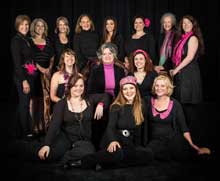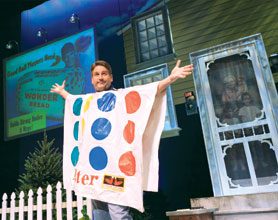From bras to bridal gowns: Ephrons’ comedy explores the culture of clothes
 We women have all had our favorite outfits – and our least favorite outfits – at different stages of our lives. And sometimes even we don’t know why we “loved” one article of clothing and “hated” another, or why we remember one piece above all others – we just do.
We women have all had our favorite outfits – and our least favorite outfits – at different stages of our lives. And sometimes even we don’t know why we “loved” one article of clothing and “hated” another, or why we remember one piece above all others – we just do.
And so it is with the characters in the Beaufort Theatre production of “Love, Loss and What I Wore” at USCB Center for the Arts on March 8, 9 and 10. Written by sister playwrights Nora and Delia Ephron, the play is a scrapbook of vignettes about women, their relationships to their clothing, and the memories they trigger.
From the unfortunate prom dress and the perfect wedding dress to the tyranny of the purse and shopping for a bra, the stories are told in a series of comedic but sometimes touching monologues and short group pieces. Chances are good that women in the audience will recognize bits and pieces of their own lives in these stories.
Recognizing the distinctive talent of co-author Nora Ephron, is not difficult either. She wrote the screenplay for the movie, “When Harry Met Sally,” and wrote and directed “Sleepless in Seattle” and “Julie and Julia,” among many others. She and Delia, co-authored the screenplay for “You’ve Got Mail,” and several other classic romantic comedies, as well as this play.
Sadly, Nora died last year at the age of 70, of complications from leukemia. In 1996 when the Ephron sisters decided to write this popular stage play based on a book by the same name by Ilene Beckerman, they expanded on the original material by adding experiences gleaned from their own lives as well as those solicited from their friends.
“I Hate My Purse”
One of these additional pieces is the witty monologue written and originally performed by their friend, Rosie O’Donnell, “I Hate My Purse.” As Nora, she declares that her observations are only for women “… who are bad at purses, who understand that their purses are reflections of negligent housekeeping, hopeless disorganization, a chronic inability to throw anything away, and an ongoing failure to handle the obligations of a demanding and difficult accessory — the obligation, for example, that it should in some way match what you’re wearing.”
Nora is played by Lady’s Island resident, Jennifer Joyce, who “— can’t imagine living anywhere else!” This is her third production with Beaufort Theatre and she most recently played the lead role of “Maggie” in last year’s “Cat on a Hot Tin Roof.” Of her character, Nora, she observes, “There are two types of women — the ones who choose their purses for form and the ones who choose in favor of function. Nora goes for function in the extreme, and probably has not changed her purse for years. If your purse is a reflection of your life then you can only imagine what her apartment looks like!”
Gail Westerfield Directs Innovative, Full-scale Production In its original format, “Love, Loss, and What I Wore” is presented as a staged reading with five stools, five music stands holding five scripts, and five actors playing multiple roles. Under Director Gail Westerfield’s creative direction, the expanded cast will not read from scripts, but rather perform in a full-scale stage production of the play. “A script as dynamic as this one just begged me to ‘put it on its feet’,” Gail explained, “and let the actors dance and throw clothes around and pop up where you might not expect them to.”
In its original format, “Love, Loss, and What I Wore” is presented as a staged reading with five stools, five music stands holding five scripts, and five actors playing multiple roles. Under Director Gail Westerfield’s creative direction, the expanded cast will not read from scripts, but rather perform in a full-scale stage production of the play. “A script as dynamic as this one just begged me to ‘put it on its feet’,” Gail explained, “and let the actors dance and throw clothes around and pop up where you might not expect them to.”
To add to the theme of the play, Gail asked a wide range of women to send her photographs of their most memorable outfits, and those of their mothers, grandmothers and daughters too! She has assembled them into a slide show that will run before the show begins. “Working on this play, I’ve been flooded with memories every day, and when the cast and I talk about our experiences, I can’t wait to take the conversations beyond us to the audience — it’s going to be a treat all around!”
Rich Mixture of Ages and Talent to Match Material
The beauty of the Ephron sisters’ creativity is that the play can be cast with women of any age in any of the parts due to the timelessness of the stories. The cast that Gail has assembled is a rich mixture of ages and talent from Beaufort and Jasper Counties to match the wide variety of material.
Cast member Suzanne Larson says of her director, “The variety in our ranks is an indication of a true artist. Gail was welcoming to all who wanted to participate and willing to take on the risk of a more involved production to give us all that chance.”
To Gail it was the enjoyment of watching the experienced and the newer actors interact, and for those new to the stage, to discover the depth of their talents. “If I do my job right, you won’t be able to tell the veterans from the newbies. They will all be telling the story together brilliantly!”
“Gingy” provides narrative thread
The lead character, “Gingy,” is the only person whose story builds in multiple monologues, providing the narrative thread that loosely binds the other recollections together. This role carries a lot of the water and is played to perfection by veteran actor Andrea Drake. With over 35 roles to her credit in community and regional theatre here and in Long Island, NY, she portrays Gingy from a young girl to a mature woman. Her most recent role was as Melissa Gardner in the Beaufort Theatre production of “Love Letters” earlier this month.
A New Yorker, born and bred, Gingy has decided that her legacy to her five children would be the story of her life illustrated with drawings of her most memorable articles of clothing because, “I wanted them to know I wasn’t always their mother. I was a girl, I had best friends, we did stupid things together.” She reminisces about growing up with her girlfriends, her three marriages, and the clothing that marked each life passage.
At the end of the play, Gingy faces the reality of aging: “There are no fashion choices when you get to a certain age. I used to show a little cleavage … but now my cleavage looks like a peach pit,” and, “When I was young there was a chain of stores called The Forgotten Woman. Now, I am that forgotten woman, and the store isn’t even in business any more.”
“What My Mother Said” full of maternal truisms
The mother-daughter acting duo, Suzanne Larson and Shawn Sproatt, and Magan Blackmon team up on a very funny rendition of “What My Mother Said,” which just about covers every maternal truism ever spoken.
Fashion tips like, “Don’t wear stripes and prints together” and “Never buy a red coat”; cutting observations like, “Is THAT what you’re wearing?” and “What did you do to your hair?”; and not-so-subtle reminders that “Nice Jewish girls do not get their ears pierced,” and “Always wear clean underpants in case you die in a car accident.”
Suzanne is well-known to the Beaufort community for her many roles in community theatre with her husband, Jon Sharp, her earlier career at SCETV, and as the recently retired Public Information Officer for Beaufort County. “The big reason I auditioned for this play was because I’d have the opportunity to work with my daughter, Shawn.”
“It’s a lot of fun working with mom,” said Shawn. “I’ve always been in awe of her talent and being together in this play has brought back some wonderful memories.” Shawn graduated from the College of Charleston with a degree in Theatre and has performed in a number of local productions.
Topics just as relevant today
Virtually all the topics that were relevant when the play was written in the late 90’s remain so today. There are also a few that are even more open and connected then 15 years ago, such as the challenge of selecting wedding garments for a lesbian couple, one of whom stands in front of a bridal shop mirror in a wedding dress and asks, “who is this person?” While at the wedding, one mother asks, “Why did they have to do this?” and the other replies, “To honor their relationship.” Shawn Sproatt and Tracy Smith portray the wedding couple.
In Geralyn’s Story, Heather Szeder’s character concentrates on the beautiful push-up bra she will wear after her breast cancer reconstruction while the doctor is drawing on her with a magic marker. She also explains her decision to have a tattoo in place of a nipple.
The Angst of the Empty Closet
In a series of “clothesline” exchanges the characters add their experiences and queries to wardrobe challenges common to all women.
One of the most common disorders of the female population is the belief that, a good bit of the time, we have nothing to wear. We stand transfixed by the seeming lack of choices while staring into a closet jammed with clothing. The Ephrons’ characters are no different. Played by Edna Crews, Jennifer Joyce, Kay Owen, and Chanel Gish, they all make observations about the paucity of their choices — “Nothing fits me.” — “Why do I buy such terrible clothes?” — “Why didn’t I hang this up? Now I have to iron it.” And a real psychological query, “My mother gave me this. Who does she think I am?”
The Traumas of the Dressing Room
Some women won’t go clothes shopping because of the trauma they suffer in dressing rooms. A few others will venture out, supported by a friend who will answer honestly when asked, “Does this make me look fat?” In a “clothesline” retrospective on The Dressing Room, the characters bemoan the problems of fit — “This will fit if I lose five pounds” — “This doesn’t fit now, but I always lose weight in May” — “Is this mirror, like, distorted?” — And another psychological observation, “I look like my mother!” Acting in this skit are Angie Brafford, Jessica Lendi Dickson, and Tracy Smith.
Buying Bras or, how many ways to be embarrassed
Without a doubt, buying a bra, whether it be the first or the fiftieth, is an undertaking filled with anxiety, if not embarrassment. Since none of us want “pendulum breasts” which, according to maternal wisdom, are what you’ll get if you don’t wear a bra, we navigate the store aisles trying to decipher the fine points of cup size versus measurement. But, as actors Anne Helm, Brittney Hiller and Heather Szeder reveal for the audience, it is as much about a rite of passage — “You couldn’t run around the house naked any more,” — “You couldn’t sit on your daddy’s lap,” as it is about an article of underwear.
CODA to benefit
Both Gail and her stage manager, Susan DeFoe, have been associated with Citizens Opposed to Domestic Abuse (CODA) for many years. “This play is a chance to help a terrific organization doing important work,” says Gail. “It celebrates both strong women and those who need some help to be strong, and seemed to be the perfect fit as a fund-raising opportunity.” CODA will receive a $1 donation for every ticket sold during the play’s three-day run.
“Although CODA is not exclusive to women,” notes Susan, who serves as CODA’s Business Manager, “we are deeply invested in a woman’s right to speak truthfully and openly, without shame. And that’s what this play is all about. It gives voice to things we think about only to ourselves, and that is very liberating as well as very funny!”
The organization will also have jewelry vendors in the lobby and “Craves” will have purple-frosted cupcakes for sale. A portion of all proceeds will go to CODA.
CAPA Closet will get a big boost
Also benefiting during the play’s run will be the Child Abuse Prevention Association (CAPA). Theatre attendees will be asked to bring one or more articles of gently worn women’s clothing with them to the play to be donated to the CAPA Closet thrift store.
“The theme of the play was just too good a fit with the CAPA Closet to not partner with them,” said Bonnie Hargrove, Executive Director for USCB Center for the Arts. “It will add another dimension of enjoyment for our attendees and, we hope, collect a lot of great clothing for the CAPA thrift shop.”
Performances at USCB Center for the Arts Theatre at 801 Carteret Street in Beaufort on Friday and Saturday nights, March 8 and 9, at 7:30 p.m., and at 3:00 p.m. on Sunday afternoon, March 10. Reserved seats are $20, general admission seats for adults are $18, and seniors’ tickets are $15.
Tickets may be purchased in advance by calling 843-521-4145. The theater’s box office opens one hour prior to performances for the purchase of tickets at the door.








